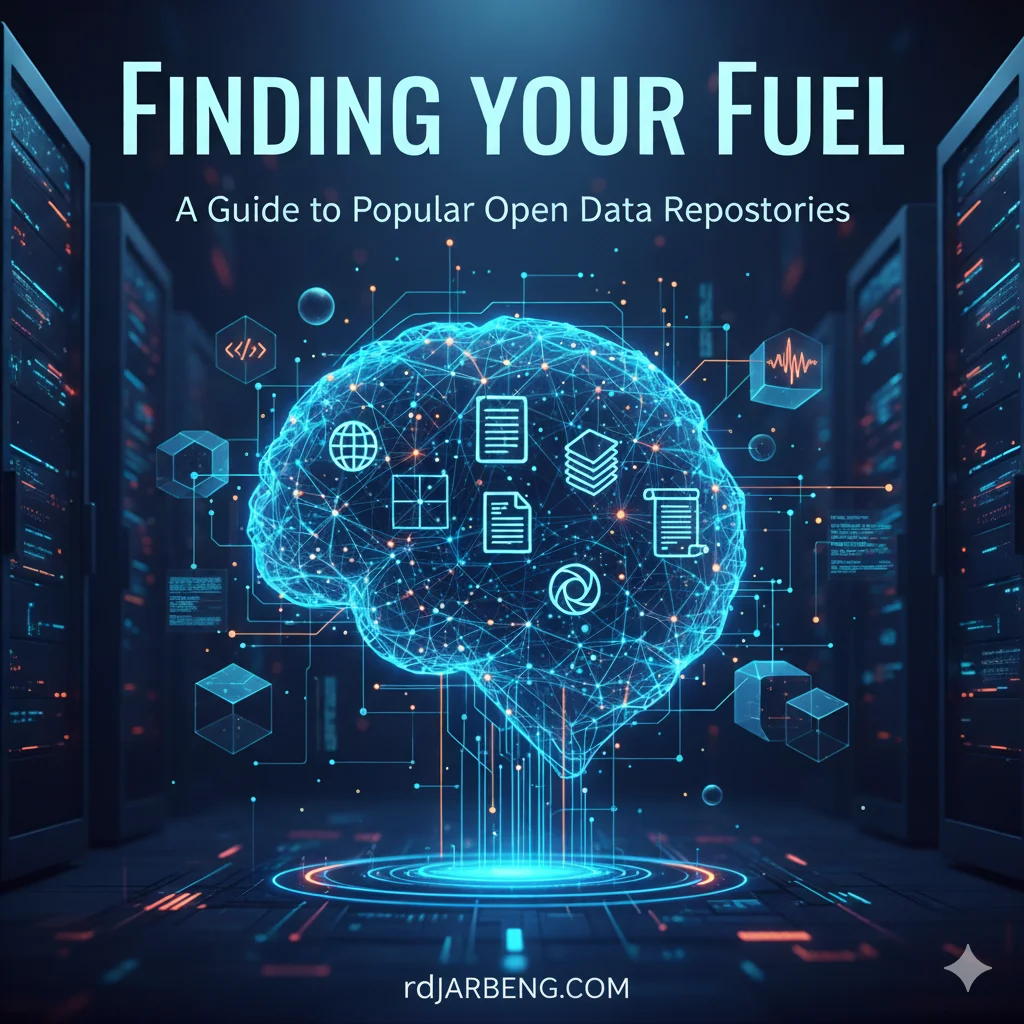Finding Your Fuel: A Guide to Popular Open Data Repositories
In data science and machine learning, data is the new oil—it’s the fuel that powers our models and insights. But finding the right data can be a challenge. Whether you’re a seasoned researcher, a data scientist looking for a competition, or a student just starting, knowing where to look is key.

Here’s a breakdown of some of the most popular and useful open data repositories available today.
1. Google Dataset Search
Think of this as Google, but specifically for data. Google Dataset Search doesn’t host data itself, but it indexes datasets from thousands of repositories across the web. It’s an excellent starting point when you have a specific topic in mind and want to see what’s available from government, academic, and private sources.
- Best for: Broad, topic-based searches across many different hosts.
- Data Types: All types (it’s a search engine).
2. Hugging Face Datasets
- **Link: https://huggingface.co/datasets
The Hugging Face Hub has become the central community for all things AI, especially Natural Language Processing (NLP). Alongside its famous transformers library and model-sharing, it hosts thousands of datasets, all easily accessible through their datasets library. It’s incredibly convenient for loading and preprocessing text, audio, and image data directly into your workflow.
- Best for: NLP, audio, and computer vision datasets; researchers and ML practitioners.
- Data Types: Primarily text, but rapidly growing in audio and images.
3. Kaggle.com
- **Link: https://www.kaggle.com/datasets
Kaggle is best known for its machine learning competitions, but it’s also a massive community and data-hosting platform. You can find thousands of user-published datasets on almost any topic imaginable. Each dataset often comes with a “Code” section where you can see how others have analyzed the data, making it a fantastic learning environment.
- Best for: Data scientists, students, and competitive ML practitioners.
- Data Types: Tabular, images, text, and more.
4. UC Irvine Machine Learning Repository
- **Link: https://archive.ics.uci.edu/
A true classic. The UCI Machine Learning Repository is one of the oldest dataset archives on the web, dating back to 1987. It’s a staple in machine learning education and research. While the datasets are often smaller and cleaner than modern “big data” collections, they are perfect for benchmarking algorithms and learning fundamental concepts.
- Best for: Students, educators, and researchers looking for classic, clean benchmark datasets.
- Data Types: Mostly tabular.
5. PapersWithCode.com
This repository is an invaluable resource for researchers. Papers With Code connects machine learning research papers to their corresponding code and the datasets they were trained or evaluated on. If you’ve just read a cutting-edge paper and want to reproduce its results or use its data, this is the first place you should look.
- Best for: ML researchers and practitioners who want to find the data and code from specific research papers.
- Data Types: All types, especially those used in state-of-the-art research (images, text, graphs, etc.).
6. OpenML.org
- **Link: https://www.openml.org/
OpenML is more than just a data repository; it’s a collaborative platform for machine learning. It allows users to upload and share datasets, code (“flows”), and experiment results (“runs”). Its goal is to make ML research more open and reproducible, allowing everyone to build on each other’s work easily.
- Best for: ML researchers and data scientists focused on automated ML (AutoML) and reproducibility.
- Data Types: Primarily tabular, well-suited for classification and regression tasks.
7. Amazon’s AWS Datasets
- **Link: https://registry.opendata.aws/
The Registry of Open Data on AWS hosts large-scale datasets that are expensive to store and transfer. By hosting them on AWS, Amazon makes them freely accessible to anyone, with the added benefit that you can analyze them directly in the AWS cloud (using EC2, S3, etc.) without paying for data transfer. You’ll find massive datasets here, like the 1000 Genomes Project, satellite imagery from Landsat, and web crawls.
- Best for: Researchers and developers who need to work with massive, petabyte-scale datasets.
- Data Types: Genomics, satellite imagery, web crawls, and other large-scale data.
8. U.S. Government’s Open Data (Data.gov)
- **Link: https://data.gov/
Data.gov is the home of the U.S. government’s open data. You can find data from across federal, state, and local governments on a huge range of topics, including climate, crime, education, finance, and demographics. It’s a goldmine for data journalists, policymakers, and civic-minded data scientists.
- Best for: Finding official data on U.S. demographics, economics, climate, and more.
- Data Types: Mostly tabular, geospatial, and document-based.
9. Stanford Large Network Dataset Collection (SNAP)
- **Link: https://snap.stanford.edu/data/
SNAP is a go-to resource for anyone working with graph or network data. Maintained by Stanford University, it contains dozens of large-scale, real-world network datasets, from social networks (like Facebook and Twitter) to web graphs and communication networks.
- Best for: Researchers and data scientists studying network analysis, graph theory, and social sciences.
- Data Types: Graph and network data (e.g., node lists, edge lists).
10. DataPortals.org
- **Link: https://dataportals.org/
This is a meta-repository, just like Google Dataset Search. DataPortals.org doesn’t host data but curates a list of over 600 open data portals from around the world. It’s organized by country, region, and city, making it an excellent tool for finding localized or government-specific data from outside the U.S.
- Best for: Finding official government data portals from specific countries or cities.
- Data Types: A directory of portals, which in turn contain all types of data.
11. Wikipedia’s List of Machine Learning Datasets
[Image of Wikipedia logo]
Don’t underestimate this resource! Wikipedia maintains several curated lists of datasets for machine learning research. These pages are often well-organized by data type (e.g., images, text, time series) and provide direct links and brief descriptions for each dataset. It’s a great way to browse for common datasets related to a specific task.
- Best for: Browsing for well-known, established datasets by task or data type.
- Data Types: A curated list covering all major data types.

